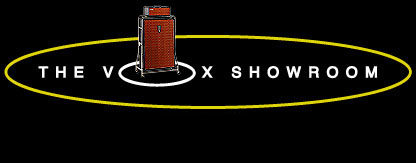| In 1960, Vox replaced the AC-30/4 with the AC-30/6. The 1965 AC30/6 "Treble" amp with factory installed swivel side stands shown at left is yet another mint condition example of this model from the North Coast Music collection.
This JMI Vox model AC-30T amp is interesting as it has three unusual cosmetic features.
Dick Denney once explained to me that the reddish/brown control panels were designed to complement the brown Vox diamond grill cloth. Gray or black control panels were normally offered on amps that had black Vox grill cloth. This amp has brown grill and a gray control panel, an unusual combination from the factory.
The unusual second feature is the Vox logo, which has three individual letters and no connecting horizontal bar. This logo was common in 1962 and 1963, but had been largely phased out by 1965.
The third unusual feature was the side swivel stands. These side stands increased the original price of the amplifier by about $100, so very few Vox dealers ordered or offered the amps with the stands.
The AC30/6 was produced in four different versions, as documented by Vox service schematics for the amp. JMI Vox schematic OS-056 depicted the "Treble" version of this amp. Schematic OS-057 was the "Bass" version, and OS-065 was the "Normal" version. The final version was the "Top Boost " version, depicted by a combination of JMI Vox schematics OS-065 and OS-010.
The electronic differences between the AC-30 Treble, Bass and Normal amps are extremely minor. The values of only two tone voicing capacitors, C3 and C10, are affected.
A brief history of the AC30/6
By 1960, the AC-30/4 had started to develop a bad reputation due to problems with the EF86 preamp tube. This tube easily developed microphonic tendencies which severely affected the tone of the amp. Vox decided to revise the circuit.
The redesigned AC-30/6 arrived in 1960. It added a third channel and replaced the troublesome EF86 with a battery of ECC83 (12AX7) twin triode preamp tubes. Unfortunately, the AC-30/6 preamp circuit had less gain and was tonally less brilliant than the AC-30/4 it replaced.
The Shadows, a UK based 1960's era guitar instrumental band that endorsed Vox amps, noticed the drop in overall level and treble response in the AC-30/6 and reported this concern back to Vox.
Vox head engineer Dick Denney felt that the best solution would be to design a treble and bass control circuit for the AC-30. Denney did a little "reverse engineering" on the tone circuits from a Fender Twin amp and developed an add-on tone control circuit that he called the AC-30 "brilliance unit." Calling the new circuit the "brilliance unit" caused some confusion to customers as the AC30/6 already had a "Brilliant" channel. As a result, Vox renamed the circuit "Top Boost."
The Top Boost circuit was built on an "L" shaped steel bracket and included the addition of an another ECC83 tube plus a Treble and Bass control. Most frequently, customers sent their AC-30/6 amps back to the factory to have the Top Boost unit retrofitted to their amps. This modification was a bit beyond the abilities of most AC-30 amp owners.
When this circuit was mounted to the rear chassis of an AC-30/6, a rectangular hole had to be cut into the upper rear vinyl covered wood back of the amp to access the controls.
It is this top boosted AC-30 configuration that is heard in early Beatle recordings.
I will add that not all shared the Shadow's opinion on the non top boosted AC-30/6. Brian May of Queen prefers his AC-30 amps without Top Boost. He uses external devices to develop his tone.
The AC-30/6 Twin had three channels, Brilliant, Normal, and Vib-Trem. If fitted with the Top Boost modification, the added Bass and Treble controls only affected the Brilliant channel. The Tone control affected all three channels.
Four ECC83, one ECC82, one GZ-34 and four EL-84 tubes were used in the Treble, Bass, and Normal versions of the AC-30/6. The Top Boost circuit required an additional ECC83 tube.
The earliest versions of the AC-30/6 were covered in fawn (light tan) vinyl with brown diamond grill cloth. In 1962, some AC-30/6 amps were covered in a smooth black vinyl. By late 1963, JMI Vox adopted a black "basket weave" vinyl for all of their amps. The fawn vinyl was phased out.
The Vib-Trem channel offered a choice between vibrato (wavering pitch) and tremolo (wavering amplitude). A rotary, three position Speed switch adjusted the the rate of modulation. An egg shaped single button foot switch operated the effect.
Two 8 ohm 12" Alnico Blue (1962-63) or Gray (1963 and later) Celestion G12 speakers were standard. The typical Celestion from this era had wire connecting lugs mounted through the speaker frame.
Offered, as an extra cost option, were both a chrome plated, tubular rigid stand or side mounted swivel stands with casters.
|



